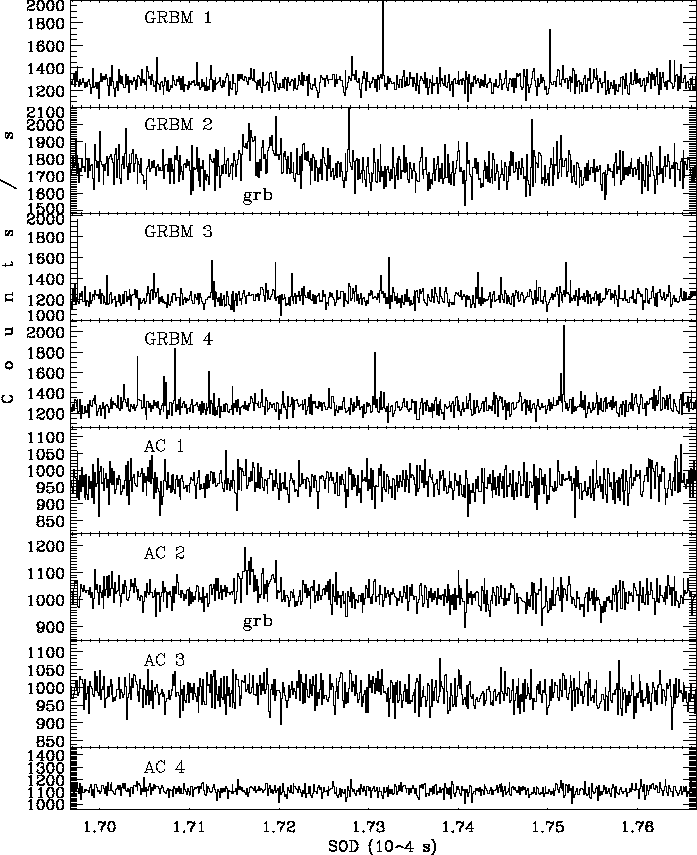 |
(8) |
The choice ![]() was adopted.
The moving average described by the eq.
was adopted.
The moving average described by the eq. ![[*]](crossref.png) is the
same as the average counts computed by the on-board logic, except for some
points: the SWTCs apply to 1 s bins, and, most important, both the GRBM
and the AC energy bands are taken into account.
is the
same as the average counts computed by the on-board logic, except for some
points: the SWTCs apply to 1 s bins, and, most important, both the GRBM
and the AC energy bands are taken into account.
Eq. ![[*]](crossref.png) applies to the bins following at least
applies to the bins following at least ![]() contiguous bins; the background estimate for the other bins,
in the nearby of the data gaps,
like the SAGA transits or other less frequent gaps in the telemetry,
and for the bins close to the boundaries of the time interval,
is computed with the same averaging process, but applied to the same
contiguous bins; the background estimate for the other bins,
in the nearby of the data gaps,
like the SAGA transits or other less frequent gaps in the telemetry,
and for the bins close to the boundaries of the time interval,
is computed with the same averaging process, but applied to the same ![]() -bin
long interval to which the scanned bins themselves belong: obviously,
this estimate is biased, since every scanned bin contributes to the estimate
of its own background; however, this rough background estimate method for
the ``more difficult'' bins, limits the number of several bursts, that,
otherwise, would be missed.
-bin
long interval to which the scanned bins themselves belong: obviously,
this estimate is biased, since every scanned bin contributes to the estimate
of its own background; however, this rough background estimate method for
the ``more difficult'' bins, limits the number of several bursts, that,
otherwise, would be missed.
Once the background in every light curve for a given bin has been estimated,
a set of eight
![]() , nearly equal to the poissonian
standard deviations of the single bin counts
, nearly equal to the poissonian
standard deviations of the single bin counts
![[*]](footnote.png) , with their correponding net signals
, with their correponding net signals ![]() are defined as
follows (eq.
are defined as
follows (eq. ![[*]](crossref.png) ):
):
When at least one among SWTC1, SWTC2, SWTC3, is satisfied,
the ![]() th bin is tagged ``good event''.
th bin is tagged ``good event''.
The choice of a lower threshold (![]() ) for the
) for the ![]() 100 keV band
than the 40-700 keV band (
100 keV band
than the 40-700 keV band (![]() ) is supported by the lower noise
in the harder range (fig.
) is supported by the lower noise
in the harder range (fig. ![[*]](crossref.png) ).
An important peculiarity of the GRBs is their spectral hardness:
generally, the GRB spectra are harder than other transient events;
this property makes the AC band fundamental in the their identification
among the other events. The SWTCs involving the AC counts are SWTC1 and SWTC2
(eqq.
).
An important peculiarity of the GRBs is their spectral hardness:
generally, the GRB spectra are harder than other transient events;
this property makes the AC band fundamental in the their identification
among the other events. The SWTCs involving the AC counts are SWTC1 and SWTC2
(eqq. ![[*]](crossref.png) ,
,![[*]](crossref.png) ); in particular, SWTC2 relaxes
the strong request of a detection in at least two units of SWTC1,
but, in addition, it requires that the normal direction to the single
triggered unit has to point to the sky, thus preventing from taking
several weak events coming from the Earth atmosphere.
); in particular, SWTC2 relaxes
the strong request of a detection in at least two units of SWTC1,
but, in addition, it requires that the normal direction to the single
triggered unit has to point to the sky, thus preventing from taking
several weak events coming from the Earth atmosphere.
Eventually, SWTC3 (eq. ![[*]](crossref.png) ) is useful to catch soft
GRBs and, in general, other transient events which are a bit
softer than typical GRBs;
since the noise in the GRBM band is stronger, the conditions on this
band must be matched simultaneously in at least three units,
in order to automatically reject the majority of events triggering
the on-board logic, due to particles crossing the detectors.
) is useful to catch soft
GRBs and, in general, other transient events which are a bit
softer than typical GRBs;
since the noise in the GRBM band is stronger, the conditions on this
band must be matched simultaneously in at least three units,
in order to automatically reject the majority of events triggering
the on-board logic, due to particles crossing the detectors.
 |